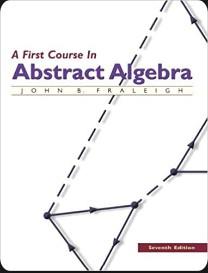Let r and s be positive integers such that gcd(r, s) = 1. Use the isomorphism in
Question:
Let r and s be positive integers such that gcd(r, s) = 1. Use the isomorphism in Example 18.15 to show that form, n ∈ Z, there exists an integer x such that x = m (mod r) and x = n (mod s).
Data from in Example 18.15
We claim that for integers r ands where gcd(r, s) = 1, the rings Zrs and Zr x Zs are isomorphic. Additively, they are both cyclic abelian groups of order rs with generators 1 and (1, 1) respectively. Thus ∅ : Zrs → Zr x Zs defined by ∅(n · 1) = n · (1, 1) is an additive group isomorphism. To check the multiplicative Condition 2 of Definition 18.9, we use the observation preceding this example for the unity (1, 1) in the ring Zr x Zs, and compute.
(∅(nm)= (nm)· (1, 1) = [n · (1, 1)][m · (1, 1)] = ∅(n)∅(m).
Fantastic news! We've Found the answer you've been seeking!
Step by Step Answer:
Related Book For 

Question Posted:





